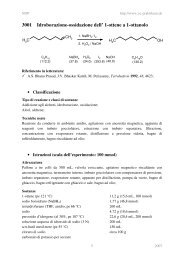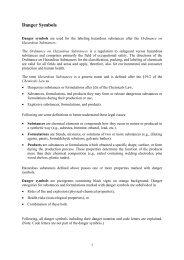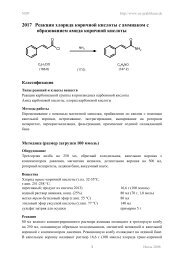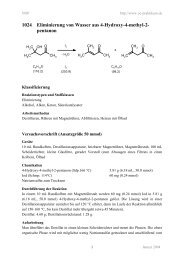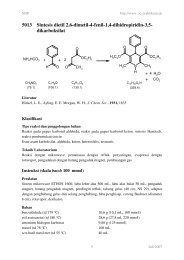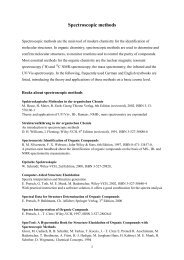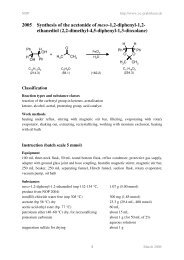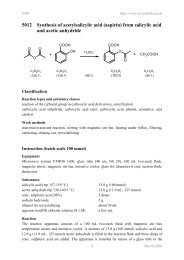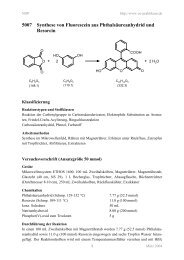4026 Synthesis of 2-chloro-2-methylpropane (tert-butyl ... - kriemhild
4026 Synthesis of 2-chloro-2-methylpropane (tert-butyl ... - kriemhild
4026 Synthesis of 2-chloro-2-methylpropane (tert-butyl ... - kriemhild
You also want an ePaper? Increase the reach of your titles
YUMPU automatically turns print PDFs into web optimized ePapers that Google loves.
NOP http://www.oc-praktikum.de<br />
<strong>4026</strong> <strong>Synthesis</strong> <strong>of</strong> 2-<strong>chloro</strong>-2-<strong>methylpropane</strong> (<strong>tert</strong>-<strong>butyl</strong> chloride)<br />
from <strong>tert</strong>-butanol<br />
Classification<br />
OH + HCl<br />
Cl +<br />
C4H10O C4H9Cl (74.1) (36.5)<br />
(92.6)<br />
Reaction types and substance classes<br />
nucleophilic substitution<br />
<strong>chloro</strong>alkane, alcohol<br />
Work methods<br />
stirring with magnetic stir bar, column distillation, filtering, use <strong>of</strong> an ice cooling bath,<br />
heating with oil bath<br />
Instruction (batch scale 10 mmol)<br />
Equipment<br />
10 mL two-neck flask, reflux condenser, bubble counter, heatable magnetic stirrer, magnetic<br />
stir bar, ice bath, separating funnel, distillation apparatus, 10 cm Vigreux column<br />
Substances<br />
<strong>tert</strong>-butanol (bp 82-83 °C) 741 mg (0.950 mL, 10.0 mmol)<br />
hydrochloric acid (conc., 36%) 3.04 g (2.56 mL, 30.0 mmol)<br />
sodium chloride<br />
sodium sulfate for drying<br />
Reaction<br />
3.0 g (2.6 mL, 30 mmol) conc. hydrochloric acid are filled in a 10 mL two-neck flask<br />
equipped with a magnetic stir bar and a reflux condenser with bubble counter (filled with<br />
paraffin oil). The mixture is cooled in an ice bath. Under further cooling and strong stirring<br />
741 mg (0.950 mL, 10.0 mmol) <strong>tert</strong>-butanol are added. The reaction mixture is stirred over<br />
night at room temperature.<br />
Work up<br />
Sodium chloride is added to the reaction mixture until the aqueous phase is saturated. The<br />
phases are separated with a separating funnel, the organic phase is dried with sodium sulfate.<br />
1<br />
H 2 O<br />
March 2006
NOP http://www.oc-praktikum.de<br />
After the drying agent has been filtered <strong>of</strong>f, the crude product is distilled over a 10 cm<br />
Vigreux column at normal pressure, leading to only one product fraction.<br />
20<br />
Yield: 639 mg (6.90 mmol, 69%); bp 50–52 °C, colourless liquid; n D = 1.384<br />
Comments<br />
A small amount <strong>of</strong> unreacted <strong>tert</strong>-butanol can be detected in the crude product. After the<br />
distillation only few side products (< 5%) are detectable. A small amount <strong>of</strong> isobutene is<br />
formed during the reaction.<br />
Waste management<br />
Waste disposal<br />
Waste Disposal<br />
aqueous phases solvent water mixtures, containing halogen<br />
distillation residue organic solvents, containing halogen<br />
sodium sulfate solid waste, free from mercury<br />
Time<br />
4 hours<br />
Break<br />
Before distillation<br />
Degree <strong>of</strong> difficulty<br />
Easy<br />
Instruction (batch scale 100 mmol)<br />
Equipment<br />
100 mL three-neck flask, reflux condenser, bubble counter, heatable magnetic stirrer,<br />
magnetic stir bar, ice bath, separating funnel, distillation apparatus, 10 cm Vigreux column<br />
Substances<br />
<strong>tert</strong>-butanol (bp 82-82 °C) 7.41 g (9.50 mL, 100 mmol)<br />
hydrochloric acid (conc., 36%). 30.4 g (25.6 mL, 300 mmol)<br />
sodium chloride<br />
sodium sulfate for drying<br />
Reaction<br />
30.4 g (25.6 mL, 300 mmol) conc. hydrochloric acid are filled in a 100 mL three-neck flask<br />
equipped with a magnetic stir bar and a reflux condenser with bubble counter (filled with<br />
paraffin oil). The mixture is cooled in an ice bath. Under further cooling and strong stirring<br />
7.41 g (9.50 mL, 100 mmol) <strong>tert</strong>-butanol are added. The reaction mixture is stirred over night<br />
at room temperature.<br />
2<br />
March 2006
NOP http://www.oc-praktikum.de<br />
Work up<br />
Sodium chloride is added to the reaction mixture until the aqueous phase is saturated. The<br />
phases are separated with a separating funnel, the organic phase is dried with sodium sulfate.<br />
After the drying agent has been filtered <strong>of</strong>f, the crude product is distilled over a 10 cm<br />
Vigreux column at normal pressure, leading to only one product fraction.<br />
20<br />
Yield: 7.60 g (82.1 mmol, 82%); bp 50–52 °C, colourless liquid; n D = 1.3858<br />
Comments<br />
A small amount <strong>of</strong> unreacted <strong>tert</strong>-butanol can be detected in the crude product. After the<br />
distillation only few side products (< 5%) are detectable. A small amount <strong>of</strong> isobutene is<br />
formed during the reaction.<br />
Waste management<br />
Waste disposal<br />
Waste Disposal<br />
aqueous phase solvent water mixtures, containing halogen<br />
distillation residue organic solvents, containing halogen<br />
sodium sulfate solid waste, free from mercury<br />
Time<br />
4 hours<br />
Break<br />
Before distillation<br />
Degree <strong>of</strong> difficulty<br />
Easy<br />
Instruction (batch scale 1 mol)<br />
Equipment<br />
500 mL three-neck flask, reflux condenser, bubble counter, heatable magnetic stirrer,<br />
magnetic stir bar, ice bath, separating funnel, distillation apparatus, 10 cm Vigreux column<br />
Substances<br />
<strong>tert</strong>-butanol (bp 82-82 °C) 74.1 g (95.0 mL, 1.00 mol)<br />
hydrochloric acid (conc., 36%) 304 g (256 mL, 3.00 mol)<br />
sodium chloride<br />
sodium sulfate for drying<br />
Reaction<br />
304 g (256 mL, 3.00 mol) concentrated hydrochloric acid are filled in a 500 mL three-neck<br />
flask equipped with a magnetic stir bar and a reflux condenser with bubble counter (filled<br />
with paraffin oil). The mixture is cooled in an ice bath. Under further cooling and strong<br />
3<br />
March 2006
NOP http://www.oc-praktikum.de<br />
stirring 74.1 g (95.0 mL, 1.00 mol) <strong>tert</strong>-butanol are added. The reaction mixture is stirred over<br />
night at room temperature.<br />
Work up<br />
Sodium chloride is added to the reaction mixture until the aqueous phase is saturated. The<br />
phases are separated with a separating funnel, the organic phase is dried with sodium sulfate.<br />
After the drying agent has been filtered <strong>of</strong>f, the crude product is distilled over a 10 cm<br />
Vigreux column at normal pressure, leading to only one product fraction.<br />
20<br />
Yield: 78.1 g (843 mmol, 84%); bp 50–52 °C, colourless liquid; n D = 1.384<br />
Comments<br />
A small amount <strong>of</strong> unreacted <strong>tert</strong>-butanol can be detected in the crude product. After the<br />
distillation only few side products (< 5%) are detectable. A small amount <strong>of</strong> isobutene is<br />
formed during the reaction.<br />
Waste management<br />
Waste disposal<br />
Waste Disposal<br />
aqueous phase solvent water mixtures, containing halogen<br />
distillation residue organic solvents, containing halogen<br />
sodium sulfate solid waste, free from mercury<br />
Time<br />
5 hours<br />
Break<br />
Before distillation<br />
Degree <strong>of</strong> difficulty<br />
Easy<br />
Analytics<br />
Reaction monitoring with IR spectroscopy<br />
1 g <strong>of</strong> the organic phase is taken from the reaction mixture and distilled over a short-path still. The distillate is<br />
used undiluted for the IR spectroscopy. The lacking <strong>of</strong> the OH-band at about 3400 cm -1 indicates, that the<br />
reaction is complete.<br />
4<br />
March 2006
NOP http://www.oc-praktikum.de<br />
1 H NMR spectrum <strong>of</strong> the crude product (300 MHz, CDCl3)<br />
1 H NMR spectrum <strong>of</strong> the pure product (300 MHz, CDCl3)<br />
δ (ppm) Multiplicity Number <strong>of</strong> H Assignment<br />
1,62 s 9 CH3<br />
The 1 H NMR spectrum <strong>of</strong> the crude product shows at 1.27 ppm the signal for the methylgroups <strong>of</strong> <strong>tert</strong>-butanol.<br />
Cl<br />
5<br />
March 2006
NOP http://www.oc-praktikum.de<br />
13 C NMR spectrum <strong>of</strong> the crude product (75.5 MHz, CDCl3)<br />
13 C NMR spectrum <strong>of</strong> the pure product (75.5 MHz, CDCl3)<br />
δ (ppm) Assignment<br />
67.25 C-CH 3<br />
34.43 CH 3<br />
76.5-77.5 solvent<br />
Cl<br />
The 13 C NMR-spectrum <strong>of</strong> the crude product shows at 31.3 ppm the signal for the methylgroups <strong>of</strong> <strong>tert</strong>-butanol.<br />
6<br />
March 2006
NOP http://www.oc-praktikum.de<br />
IR spectrum <strong>of</strong> the pure product (film)<br />
7<br />
cm -1<br />
(cm -1 ) Assignment<br />
2982, 2868 C-H-valence, alkane<br />
1457 C-H-deformation<br />
811 C-Cl-valence<br />
March 2006



